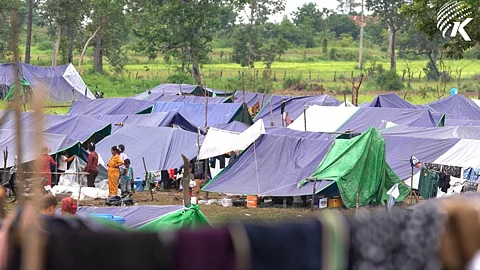
- Home
- NG Hindi
- India
- World
- Politics
- Sex & Relationships
- Entertainment
- Culture
- Lifestyle
- Economy
- Sports
- Sp. Coverage
- Misc.
- NewsGram Exclusive
- Jobs / Internships

Thai and Cambodian citizens are calling for de-escalation amid the intensified border conflict between the two neighboring countries in Southeast Asia.
The border dispute has existed for several decades as the two countries disagree over the ownership of an ancient Hindu temple in Preah Vihear. Violence has erupted numerous times due to the dispute, leading to exchanges of gunfire in 2008 and 2011.
The tension eased in recent years, but it sparked again two months ago after a minor clash involving soldiers from both sides. The contested area focused on Ta Muen Thom and Ta Kwai temples in Thailand’s Surin province and Preah Vihear and Oddar Meanchey provinces in north Cambodia.
The conflict intensified on July 24, displacing thousands of civilians affected by airstrikes, bombings, and grenade blasts. A truce was tentatively enforced on July 29, but both countries have accused the other of violating the ceasefire agreement.
On July 25, Thailand’s Public Health Ministry announced that 14 civilians had been killed and 31 wounded by Cambodian artillery attacks. Over 100,000 people from border areas were evacuated, while 852 schools and seven hospitals were closed for safety reasons.
According to Cambodian media outlets, around 169,000 Cambodians have been displaced by border clashes as of July 29.
Cambodian news website Kiripost interviewed Preah Vihear temple guard Sen Sokha about their escape during the bombing attacks.
Kiripost also interviewed Sombat Socheata, who survived a Thai military drone attack on July 28 in Kon Kriel village, Samrong City, Oddar Meanchey province.
Over 12,000 displaced civilians are facing harsh conditions in an evacuation center in Koh Ker, as shown in this video.
Youk Menglong, a Cambodian studying in Thailand, highlighted the plight of residents living near the border conflict.
Aside from residents, migrant workers are also affected. There are reports of attacks targeting Cambodian and even Myanmar workers in Thailand. Myanmar independent media Mizzima noted that “this case is a reminder that public sentiment and the realities on the street are closely linked, and migrants often suffer due to conflicts they cannot control.”
As the conflict led to massive displacement, concerned citizens appealed for peace while mobilizing public support to gather donations and supplies for civilians in refugee centers and church shelters.
Human rights group Forum Asia asserted that “civilians living in the border areas should not have to live in fear.” Cambodian civil society groups signed a statement urging both governments to restore stability and address the humanitarian crisis in the border area.
Thailand-based news website Khaosod English pointed out the irony of the violence surrounding sacred sites.
Khaosod English senior writer Pravit Rojanaphruk has this piece of advice to avoid the misleading propaganda being shared by ultranationalists from the two countries.
[GlobalVoices/VS]
